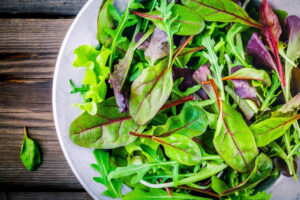25 Aug Green Leafy Vegetables – How much to have in a day?
Green Leafy Vegetables are a necessary food that is also extremely beneficial for maintaining good health. They contain significant foods that have the potential to effectively develop and repair various parts of the body. Similarly, Green Leafy Vegetables like spinach and other leafy vegetables contain many vitamins and nutrients. Spinach, cabbage, and lettuce are high in dietary fibre, which helps to prevent constipation. Dark green leafy vegetables are important sources of protective foods and play an important role in our nutrition and diet. They have also been used as medicine since ancient times. To gain more information related to Green Leafy Vegetables go through the content below.

Leafy greens benefits
Green leafy vegetables are the best sources of essential amino acids, minerals, vitamins, and fiber that are readily available. Their bioactive elements have a variety of biological applications, including antimicrobial and antioxidant activities, and are very beneficial in the treatment of age-related ailments and oxidative strains. Dark green leafy vegetables contain more vitamin K than other vegetables and fruits because of their photosynthetic material. Green leafy vegetables are also high in compounds with antidiabetic, antihistaminic, anticarcinogenic, and hypolipidemic properties, as well as the ability to act as preventive agents for aging, insomnia, obesity, hypertension, and cardiovascular disease. Green leafy vegetables contain a high concentration of phytochemicals and antioxidants.
Greens are good for you
Many studies have found that diets high in vegetables and fruits benefit human health by protecting against age-related degenerative diseases such as CVD, Alzheimer’s disease, several types of cancer, and cataracts. Aside from the major food components like carbohydrate, protein, and fat and micronutrients like minerals, vitamins, and trace elements, there are numerous compounds in fruits and vegetables that have been linked to health-promoting effects. These compounds include phytochemicals such as flavonoids, carotenoids, and other polyphenols, glucosinolates, isothiocyanates, allylic sulphides, phytosterols, monoterpenes, dietary fibres, and phenolic acids, which are essential for anyone to live a healthy life.
Types of greens
Here are the types of green leafy vegetables.
- Turnip greens
- Swiss chard
- Spinach
- Mustard greens
- Broccoli
- Romaine lettuce
Vegetable for health and its Anti-Inflammatory property
Green leafy vegetables are widely consumed in a variety of forms, including fresh and processed. Humans have consumed these vegetables for centuries and they have been declared safe. Green leafy vegetables are well-known for both their aesthetic and therapeutic properties, such as flavor, colour, and so on. Furthermore, it is believed that their bioactive substances and phytonutrients perform a variety of biological processes and act as anti-inflammatory agents.
Also Read: What Are Starchy Vegetables? Do You Need It?
Greens nutrition and Antidiabetic Properties
Green leafy vegetables with varying levels of antioxidants, vitamins, carbohydrates, phytochemicals, and minerals include cabbage, spinach, kale, lettuce, and broccoli. These compounds play an important role in preventing CVDs and diabetes. Different biological mechanisms are in charge of reducing the risk of diabetes. In addition to the high fiber content, low glycemic loads, and low energy intake, leafy green vegetables contain high amounts of magnesium, potassium, antioxidant vitamins, phytochemicals, and plant proteins, which are responsible for lowering the risk of type 2 diabetes. Green leafy vegetables are a low-cost, high-nutritional-value source of phytochemicals and micronutrients with antioxidant properties. These important compounds are abundant in lettuce leaves, reddish leaves, and omum leaves.

Eating green: Best Dietary Fiber
Generally, raw veggies have less total dietary fiber than cooked vegetables. A Health Promoting Source D. For raw vegetables, the nutrition and reproduction value of soluble dietary fiber varies from 0.10 to 0.77% while the value of insoluble dietary fiber ranges from 0.88 to 3.06%. TDF levels range from 3.50% in broccoli to 0.98% in iceberg lettuce.
Most nutritional vegetable and how it helps Fertility
Minerals, vitamins, antioxidants, fiber, and chlorophyll are abundant in dark leafy green vegetables. They can be eaten raw or cooked however, eating them raw or half cooked is preferable because cooking diminishes vitamins and antioxidants, particularly those vital for fertility such as zinc, vitamin C, and folate. Greens like broccoli, Brussels sprouts, and cabbage contain diindolylmethane, which aids the body in eliminating excess “bad” oestrogen. These green should be consumed at least three times a week.
Conclusion
Green leafy vegetables are a rich source of important vital nutrients. The leafy vegetables contain a high amount of dietary fiber thus, they help in alleviating obesity and diabetes. Try to consume 2 cups of dark, leafy vegetables every day, such as collards. A cup of vegetables is two cups of raw greens, and a 2000-calorie diet asks for 2.5 cups per day. Micronutrients are essential for growth, and maternal micronutrient deficiency in developing countries may be an important cause of abortion. However, if we add leafy green vegetables, we can decrease the prevalence of such diseases. Green leafy vegetables and fruits are rich in antioxidants and GRAS.
FAQs
1. What are green leafy vegetables?
Here are the green leafy vegetables list that can be added to your diet.
- Spinach
- Kale
- Collard Greens
- Bok Choy
- Swiss Chard
- Romaine Lettuce
2. How much green leafy vegetables to have in a day?
Every day, aim for 2 cups of dark, leafy greens like collards. Two cups of raw greens equal one cup of vegetables, and a 2000-calorie diet calls for 2.5 cups per day.
3. What is high in green leafy vegetables?
Green leafy vegetables contain high amounts of magnesium, potassium, antioxidant vitamins, phytochemicals, and plant proteins.
4. Is cauliflower a type of green leafy vegetable?
Green leafy veggies that are commonly consumed include Cauliflower. It is a very healthy vegetable that provides vitamins including thiamine (vitamin B1), pantothenic acid, pyridoxine, and folic acid. It also contains Omega-3 fatty acid, vitamin K, etc.
5. Which salad is the healthiest to eat?
When it comes to leafy vegetables, dark leafy greens are better. They are the most nutrient-dense. For example, kale and spinach have more immune-boosting vitamins A and C when compared to other leafy greens.
REFERENCE
https://www.sciencedirect.com/science/article/pii/B9780128008720000184

No Comments